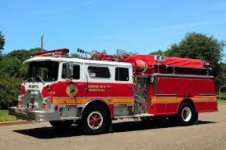- Joined
- Sep 7, 2020
- Messages
- 2,600
Looking back now, the team that designed the FDNY Mack CF’s beginning in 1969 and through the 70’s were truly innovative and trend setting. They introduced so many new concepts to fire apparatus in a single package. Although some of the ideas may have been utilized by a department here and there, the fact that all these features and innovations were placed on a single rig, and those rigs were FDNY- a department that has National and international exposure like no other. These innovations included:
1. An extremely short wheelbase and overall vehicle length for use in tight urban environments 2. Front suction intake, 3. Hosebed cover (conestoga type) 4) Diesel engines - as late as the mid to late 70’s manufacturers were still building rigs with gasoline engines like the Waukaushau engine 5. The vertical booster tank - typically booster tanks were sandwiched between the chassis rails and the bottoms of the hosebed the vertical booster tank moved the center of gravity more midship and lowered the hosebed 6. Low hosebed - aided in repacking and quicker deployment of hose - ironically by the beginning of the 21 century many hosebed were 7-8 feet or more above the street. A growing trend now is the get hosebeds lower once again 7. Placing the booster reel under the hosebed near the tailboard - freeing up space on top of the pump panel. 8. The portable Stang - mounted on top of the pump house and preconnected via a short hose for use as a fixed deck gun yet removable for use as a portable ground monitor with the grating style base - this was the precursor to later monitors developed by Akron and Elkhart such as the Apollo and stinger. 9. Narrower pump panel - decreased vehicle length and wheelbase. 10. Vertical exhaust. - at that time it redirected the diesel fumes away from the side of the rig - eventually became a huge industry wide option until the advent of the 2007 and later Diesel engines with DPF fluid 11. The 4 door cab. Although the original versions in 1969-1971 did not have four door cabs, the rapid transition afterwards to 4 door engines became the industry standard with 15-20 years. We take all of these features for granted today and in some cases like the vertical exhaust have moved onto better technology. Looking back, the FDNY and Mack design team were revolutionary at that time and the results of their innovations were a true game changer for the Fire service.
1. An extremely short wheelbase and overall vehicle length for use in tight urban environments 2. Front suction intake, 3. Hosebed cover (conestoga type) 4) Diesel engines - as late as the mid to late 70’s manufacturers were still building rigs with gasoline engines like the Waukaushau engine 5. The vertical booster tank - typically booster tanks were sandwiched between the chassis rails and the bottoms of the hosebed the vertical booster tank moved the center of gravity more midship and lowered the hosebed 6. Low hosebed - aided in repacking and quicker deployment of hose - ironically by the beginning of the 21 century many hosebed were 7-8 feet or more above the street. A growing trend now is the get hosebeds lower once again 7. Placing the booster reel under the hosebed near the tailboard - freeing up space on top of the pump panel. 8. The portable Stang - mounted on top of the pump house and preconnected via a short hose for use as a fixed deck gun yet removable for use as a portable ground monitor with the grating style base - this was the precursor to later monitors developed by Akron and Elkhart such as the Apollo and stinger. 9. Narrower pump panel - decreased vehicle length and wheelbase. 10. Vertical exhaust. - at that time it redirected the diesel fumes away from the side of the rig - eventually became a huge industry wide option until the advent of the 2007 and later Diesel engines with DPF fluid 11. The 4 door cab. Although the original versions in 1969-1971 did not have four door cabs, the rapid transition afterwards to 4 door engines became the industry standard with 15-20 years. We take all of these features for granted today and in some cases like the vertical exhaust have moved onto better technology. Looking back, the FDNY and Mack design team were revolutionary at that time and the results of their innovations were a true game changer for the Fire service.

